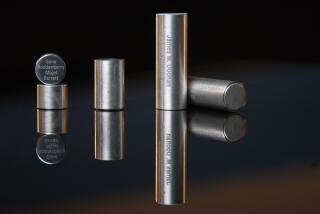Astronaut-Physician Counting Down to Blastoff Aboard Russian Craft : Shuttle: Dr. Norman Thagard will become the first American to leave the Earth aboard a Soyuz rocket. Mission will take them to the Mir space station.
- Share via
SPACE CENTER, Houston — After four space shuttle flights, Dr. Norman Thagard was itching for a new adventure. He found it: Early this year, he will become the first American to leave Earth in a Russian rocket ship.
First an engineer, then a Marine, fighter pilot, physician, astronaut and, now, cosmonaut. Without a doubt, the man craves new challenges.
“That was one of the things that had a huge attraction for me in all of this, the unique aspect of being able to fly in a Russian rocket,” said Thagard, 51, during a quick trip back to the Johnson Space Center.
“It’s a thrill to ride a rocket. But still, all in all, after four times you start to look for a new experience.”
Thagard has been living at cosmonaut headquarters in Star City outside Moscow since last February, training exhaustively for his trip to Russia’s space station, Mir (Russian for peace).
He will blast off on a Russian Soyuz rocket in March with two Russian cosmonauts. The three men will spend three months on Mir before space shuttle Atlantis swings by to pick them up.
It will be the first time a NASA space shuttle docks with Mir; at least seven such dockings are planned through 1997. Atlantis will take up two Russian cosmonauts who will stay behind on Mir when Thagard and the rest leave in June.
Thagard’s three-month trip may be modest by Russian standards, but it would set a U.S. space endurance record. Cosmonaut Vladimir Titov, who will fly on space shuttle Discovery in February, once spent a year on Mir.
No American has spent more than 84 days in space at a time, and that was more than 20 years ago on NASA’s only space station, Skylab.
The longest stay in space by Americans since: 15 days.
Thagard’s longest space trip: eight days.
“I think I can easily do three months,” Thagard said. “I guess if the shuttle were not to get there on time, it could stretch into six months. Six months might be the limit of what I could do.”
His wife of 29 years, Kirby, says the separation will be no different than when he was flying combat in Vietnam, or when he went to Russia in February and she stayed behind in Houston to finish the school year.
Kirby Thagard, a schoolteacher, moved to Star City in June with the youngest of the couple’s three sons, Daniel, 15. She’s teaching English at the local school and tutoring Daniel. They’ll stay through the March 14 launch and then return home to Houston.
The Thagards are part of a small NASA contingent at Star City, a military base where cosmonauts train for space flights.
It is an isolated existence: no English-language newspapers, no English news broadcasts, no video rentals, lousy telephone communications, and a 75-minute drive to Moscow for groceries. To get to Moscow, Thagard or his wife must reserve a chauffeur-driven car one day in advance.
“The plus for me, not for my family, is that I have to do everything--take technical courses and pass oral exams--in Russian,” he said. “So obviously I need to spend a lot of time studying, and the isolation helps that aspect.”
“I can handle loneliness,” he added. “It’s a pretty good trait being one of three people on a space station.”
Or one of three people stuck for 48 hours in the woods--in Siberia in winter. Thagard, his backup, astronaut Bonnie Dunbar, and his commander, Russian cosmonaut Vladimir Dezhurov, chopped wood and built shelters in deep snow as part of winter survival training.
For water-survival training, they bobbed around in a Soyuz capsule before being pulled from the lake by helicopters.
NASA’s space shuttles glide to a landing on a runway in Florida or California. Russian space capsules parachute down in the deserted steppes of Kazakhstan, sometimes bouncing into a cornfield.
As for the rigors of the classroom, Thagard receives nine hours of instruction a day in Russian rocketry and, to a lesser degree lately, the Russian language. Language was his biggest hurdle; he’s now fluent.
“Very often, we don’t have to explain to him a lot,” Dezhurov said. “We just have to say a couple of words, and he understands it right away.”
Thagard began studying Russian in 1992 as soon as NASA asked him to go to Mir to conduct medical research. He was an ideal choice--an astronaut since 1978 plus a licensed physician, a naval aviator with 16 medals and, according to family and colleagues, a workaholic who is incredibly focused.
He will be only the fourth person in the world to be launched in both U.S. and Russian spaceships; the first was Russian cosmonaut Sergei Krikalev who flew on space shuttle Discovery in February. Astronauts and cosmonauts mingled in orbit during the 1975 Apollo-Soyuz docking mission, but went up and down in their own craft.
Four American astronauts will follow Thagard to Mir through 1997, but they’ll go up on Atlantis--not a Soyuz. The United States, Russia and other countries then will start building a new, joint space station that is supposed to be completed in 2002--sooner than it would be without the Russians and bigger, too, said NASA Administrator Daniel Goldin.
Thagard will spend most of his time on Mir conducting medical tests on himself, Dezhurov and cosmonaut Gennadiy Strekalov. He’s interested in how the heart, bones and muscles weaken in weightlessness, and what can be done to prevent this.
Most of Thagard’s biomedical gear, unfortunately, won’t get to Mir until two months into his station stint. The equipment was supposed to arrive in February, 1995, with a new Mir module, but the launch slid to May because of delays by the Russians in getting their module ready and problems clearing the U.S. tools through Russian customs.
Ever diplomatic, you won’t hear Thagard complaining about that, or about recent docking and power problems at Russia’s aging space station.
“I try to be non-critical,” he said. “I certainly would not like to be the one who let us down.”
More to Read
Sign up for The Wild
We’ll help you find the best places to hike, bike and run, as well as the perfect silent spots for meditation and yoga.
You may occasionally receive promotional content from the Los Angeles Times.






